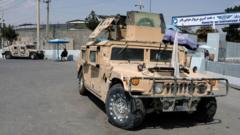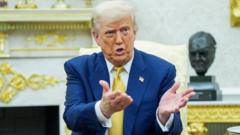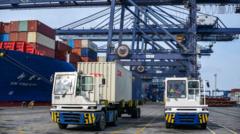Following the U.S. withdrawal from Afghanistan in 2021, an estimated half a million weapons were unaccounted for, with many reportedly sold or smuggled to militant factions including affiliates of al-Qaeda. The Taliban insists that they are safeguarding their arms, yet UN reports highlight widespread issues with weapons distribution and smuggling amid allegations of a thriving black market. This situation underscores the complexity of post-war security dynamics in the region.
U.S. Military Equipment in Afghanistan: A Double-Edged Legacy

U.S. Military Equipment in Afghanistan: A Double-Edged Legacy
A BBC report reveals that significant amounts of U.S. military equipment in Afghanistan have fallen into the hands of the Taliban and may now be sold to militant groups, raising concerns over security and the future of regional stability.
In the wake of the U.S. withdrawal from Afghanistan in 2021, a startling number of weapons and military equipment originally funded by American taxpayers have reportedly fallen into the hands of the Taliban and potentially other militant groups. According to sources cited by the BBC, about half a million weapons are now unaccounted for, prompting concerns regarding regional security and the proliferation of arms.
When the Taliban seized control, approximately one million items of weaponry and military gear were left abandoned, primarily due to Afghan soldiers abandoning their posts or fleeing. This inventory not only included weapons like M4 and M16 rifles but also outdated arms left from decades of conflict.
At a recent closed-door United Nations Security Council meeting, Taliban representatives reportedly acknowledged that a significant portion of this weaponry is now “unaccounted” for. The 2023 UN report shed light on a troubling trend, alleging that various groups, including al-Qaeda affiliates like Tehreek-e-Taliban Pakistan and the Islamic Movement of Uzbekistan, are seeking weapons that have either been captured or are available on the black market.
Hamdullah Fitrat, the deputy spokesperson for the Taliban government, asserted their commitment to properly managing their stockpile and denied claims involving smuggling or the loss of arms. However, reports suggest that the Taliban has permitted local commanders to maintain 20% of the seized weaponry, facilitating a thriving black market trade that raises concerns about local autonomy and arms distribution.
The existence of underground arms markets has also emerged, with accounts indicating that trading in U.S. weapons continues through messaging platforms like WhatsApp. A former journalist described how the arms market has shifted from open displays to covert transactions, predominantly involving weapons left by U.S.-backed forces.
While a U.S. body responsible for overseeing Afghan reconstruction projects, Sigar, has reported fewer weapons than those cited by BBC's sources, it acknowledged significant limitations in tracking these items. The Department of Defense has faced criticism for these shortcomings, and the State Department's attempts to provide oversight have also been challenged.
In the political arena, former President Donald Trump has expressed a strong desire to reclaim U.S. military equipment left behind in Afghanistan, asserting that approximately $85 billion worth of advanced weaponry was abandoned. Yet, experts challenge the accuracy of this figure, arguing that expenses also included funding for training and other non-material costs.
In response, Zabihullah Mujahid, a spokesperson for the Taliban, claimed that the weapons were seized from the previous administration and would be utilized to defend the nation. The Taliban's display of captured U.S. weaponry has become a symbol of their strength and legitimacy.
Despite the Pentagon's claims that the abandoned equipment was rendered non-operational, the Taliban has reportedly demonstrated an ability to utilize various less complex military assets, while more sophisticated machinery like Black Hawk helicopters may remain functional but underutilized.
As discussions regarding the potential reclamation of these arms continue, experts like John Sopko caution that such endeavors may be futile, potentially incurring costs that outweigh any practical benefits. The situation remains fluid, and the unresolved distribution of arms poses ongoing risks not just for Afghanistan but for the wider region.





















